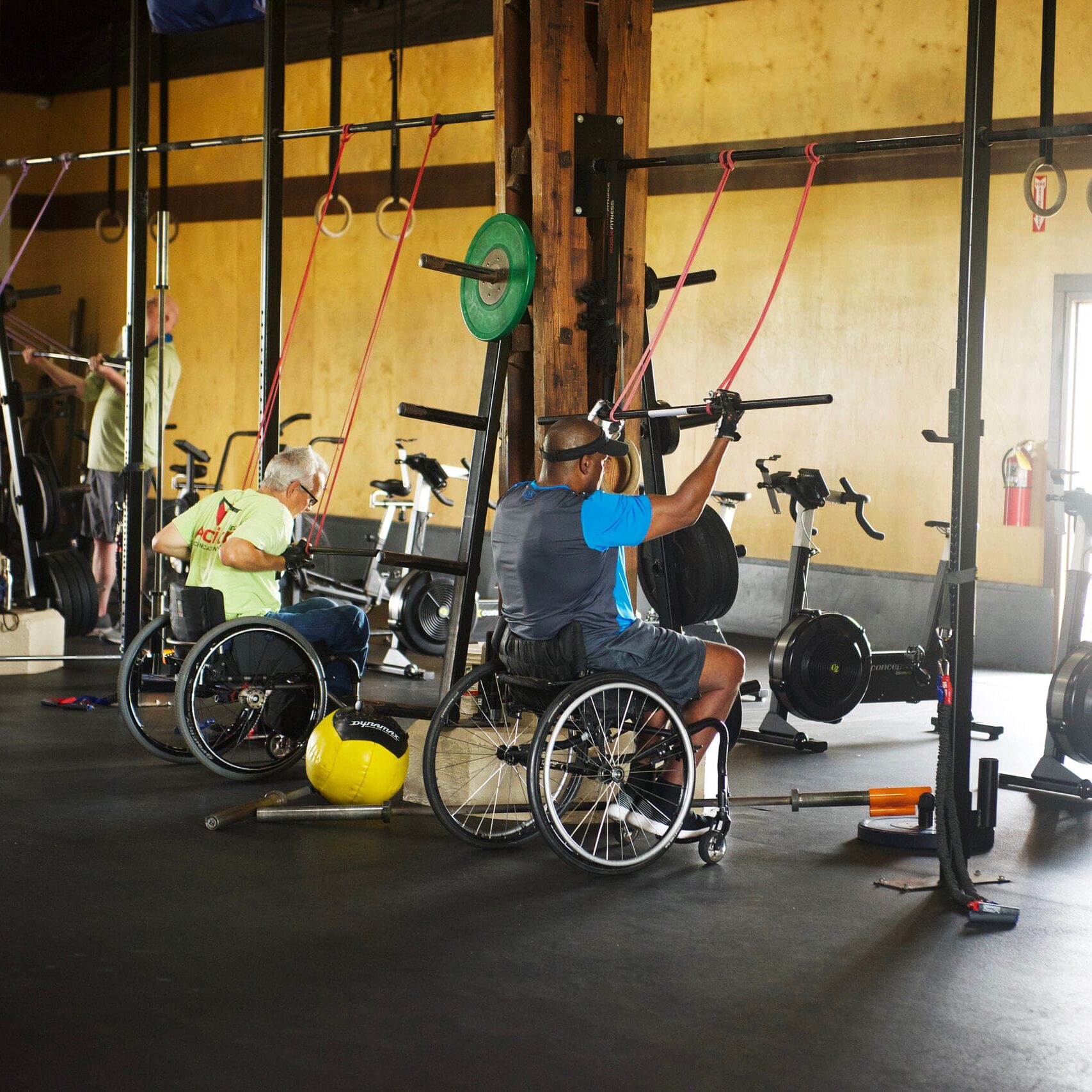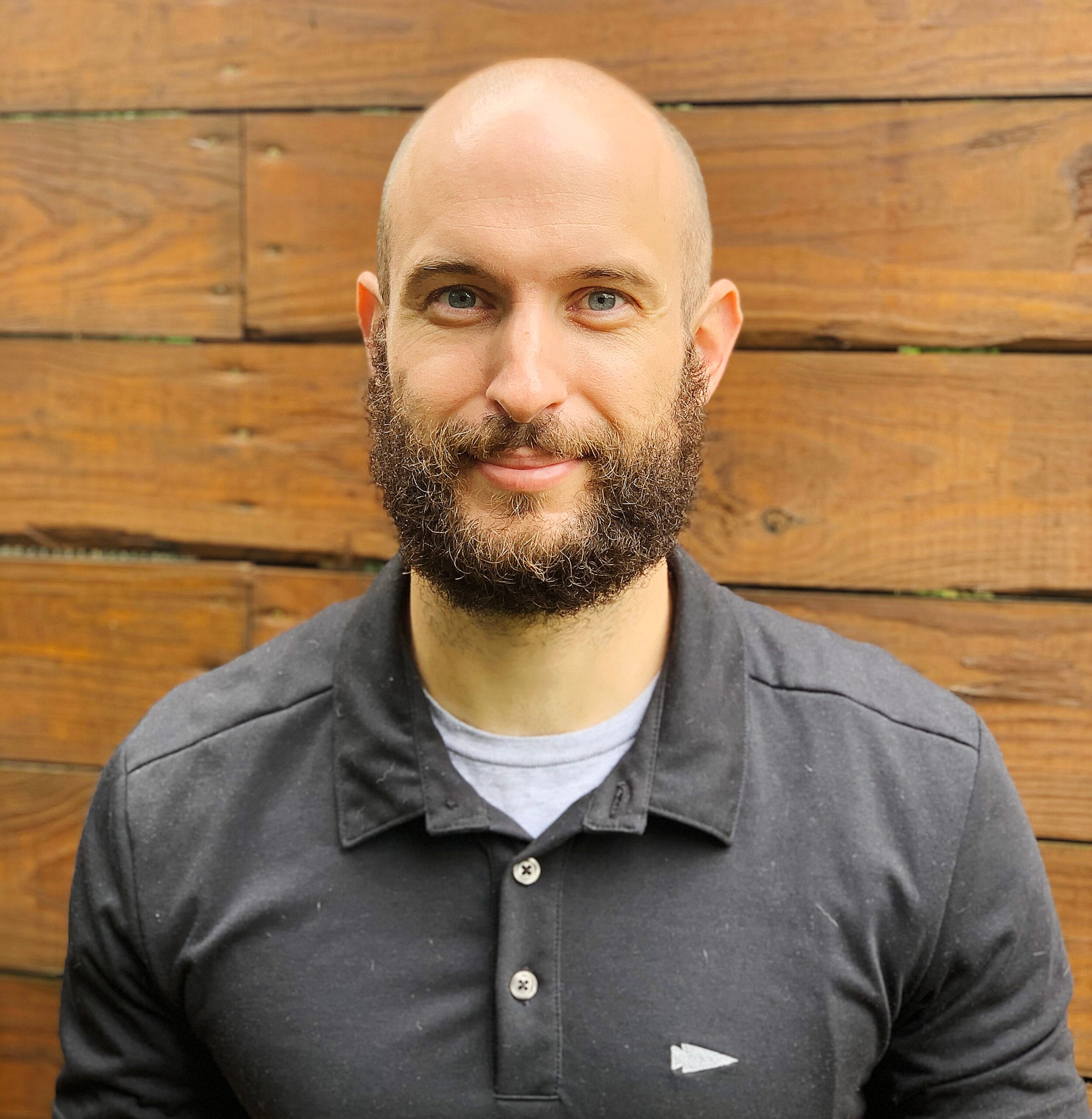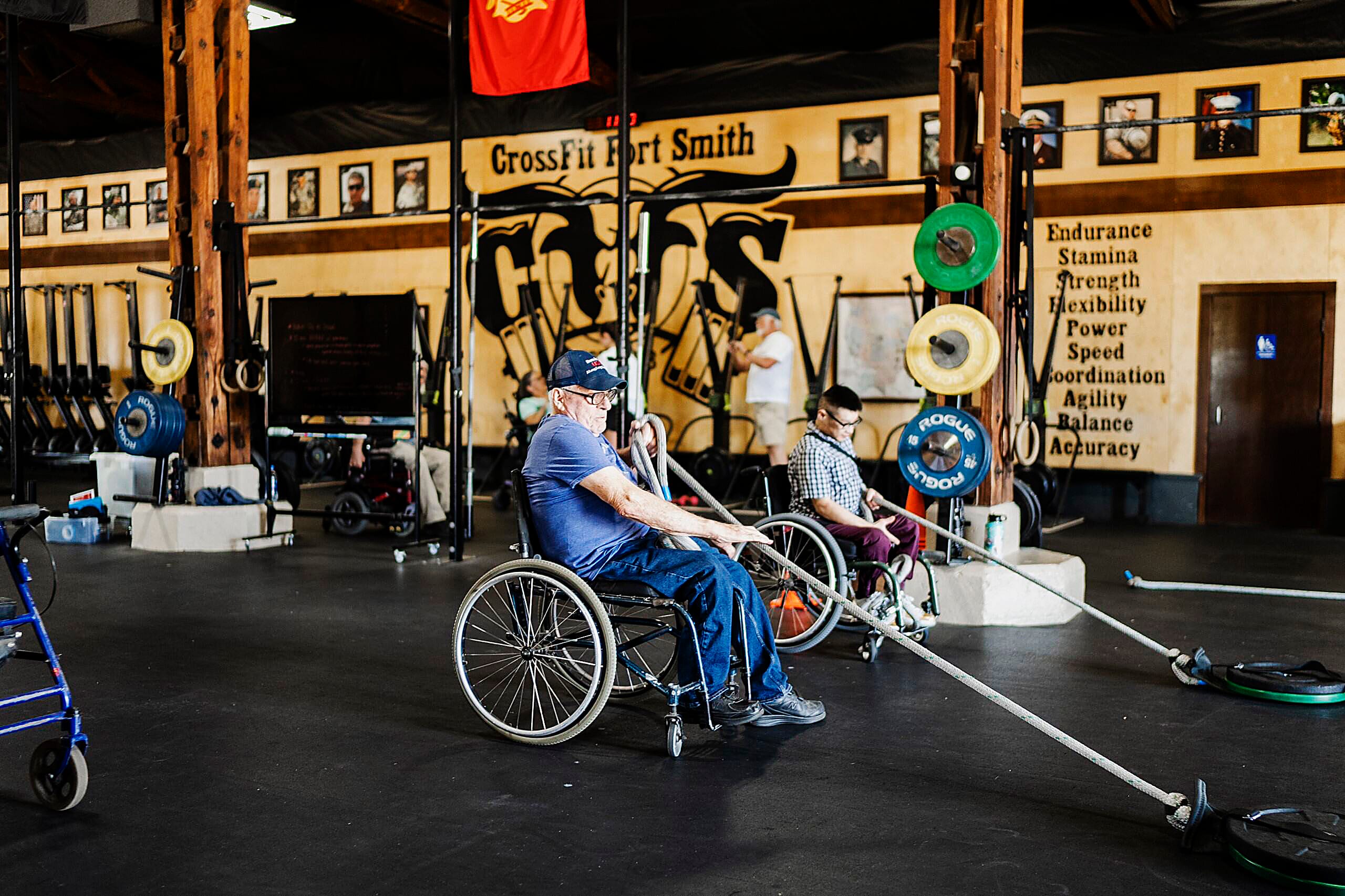
We all know that exercise is important. Getting active on a regular basis can prevent or manage a wide range of physical and mental health conditions, improve our mood, and boost our energy. You’ve heard this message before.
But here at The Spin, we know that “getting more exercise” is easier said than done. That’s why you’ll find stories about the latest research on technologies, equipment, apps, and programs designed to make exercise easier to access and more enjoyable for people with SCI in almost every issue that we publish.
The innovations we’ve featured offer a wide variety of options to help our readers with SCI get active. But what about the readers who care for and support people with SCI? What you may not know is that the health of people with SCI and their care partners is often linked—and that exercise can be an important factor in maintaining health and wellbeing on both sides of the equation.
That’s what led Dr. Reed Handlery, an Assistant Professor in the School of Physical Therapy at Arkansas Colleges of Health Education, to design an exercise program specifically for people with SCI and their care partners. He is also the lead author of a new study examining the feasibility of the program and its impact on participant outcomes—a first of its kind to include care partners alongside participants with SCI.
“Care partners often experience worse health than people who do not provide care, including higher risk of cardiovascular disease and higher rates of depression and anxiety,” says Handlery. “There hasn’t been, to my knowledge, a lot of research specifically on the physical health of care partners of people with SCI, but we do know that it’s a dyadic relationship where the health of one partner impacts the health of the other.”
For example, if you live with SCI and your health is compromised—perhaps you develop a pressure wound or injure your shoulder—you may rely on a care partner for help with daily tasks like mobility and self-care more than usual. And when care partners are faced with more demands, they are less likely to engage in health-protecting activities like exercise. Meanwhile, care partners who experience an injury or poor health may be unable to provide the level of support they might typically provide. This, in turn, can impact the health and wellbeing of the person they are caring for. It’s a cycle that may repeat itself to the continued detriment of both people with SCI and the care partner, often a spouse or family member.

“Care partners seem to be neglected in terms of exercise and physical activity interventions,” explains Handlery. “Usually, those interventions are just targeting the person with the diagnosis. But if care partners are helping with transportation or other things and they’re going to show up to the gym anyways, let’s go ahead and try to improve their health through exercise as well.”
With an accessible CrossFit gym 200 metres from his office, Handlery wondered if the popular, often partner-based style of working out would be a good fit for people with SCI and their care partners.
CrossFit is the most common form of High Intensity Functional Training (HIFT), an exercise program that uses various functional movements performed at a high intensity to improve general fitness and performance. It combines aerobic and strength-training exercises that specifically target regular, everyday patterns of movement—from wheeling or walking to bending over to lift an object from the ground. “It’s a fancy way of saying exercise performed at high intensity that largely represents movements you do in daily life,” says Handlery.
CrossFit, or HIFT, checked several boxes when it came to designing an exercise program that would benefit people with SCI and care partners. “HIFT has a lot of variety, which lends itself well to people with SCI and care partners who may have different ability levels,” explains Handlery. “It also allowed us to meet SCI-specific exercise guidelines, which at a minimum is moderate to vigorous aerobic exercise for 20 minutes twice a week, and then strength training twice a week for three sets of 10.”
Another feature of HIFT that appealed to Handlery was its emphasis on working out in community with others. “HIFT includes partner workouts where, for example, you and I work together to lift a weight that we wouldn’t be able to lift individually,” says Handlery. “It fosters a sense of community that I don’t think you get with individual exercise programs or even group classes where the focus isn’t necessarily on the team or on partners.”
Facilities for HIFT are widely available around the world, and they’re often accessible, adds Handlery. “They’re usually giant warehouses with big garage doors, so you can roll or walk right in. These gyms usually have a very open floor plan, so you don’t need to weave in and out of treadmills or anything like that. It’s very bare bones, a lot of free space, which is important for individuals who may use a power or manual wheelchair.”
So, Handlery recruited 14 people with SCI and six care partners to take part in a 25-week HIFT program. Participants took part in two sessions per week, each about 75 minutes in length, at a CrossFit facility with accessible restrooms, parking, and floor plan in Fort Smith, Arkansas.
“Some specific things that we brought in to make the gym even more accessible included things like grip aids and ropes with loops and knots. We also introduced a variety of lighter, smaller weights,” explains Handlery. Otherwise, the program made use of common CrossFit equipment, including squat racks, air-bikes, row ergometers, and medicine balls.
Two coaches, both licenced physical therapists, one with a CrossFit coaching certification, led the program. The coaches tailored the sessions to manual wheelchair users first, then adapted the programming to meet the needs of power chair users and people who walk. Each session was designed to meet or exceed SCI-specific exercise guidelines and consisted of three parts: a warm-up focused on shoulder strength and stability, a HIFT workout, and a cool-down.
The bulk of each session, called “the workout of the day,” lasted anywhere from 20 to 60 minutes. No two workouts were the same, and more than 100 different exercises were featured across the 25 weeks. “HIFT is kind of all exercises in a blender, so it’d just be everything you could possibly think of, adapted to meet the needs of each participant. And the important thing is that it’s performed at a high intensity. That doesn’t mean every single exercise, but for the most part you are trying to do things at a high intensity,” says Handlery.
While participants with SCI and their care partners would typically arrive and leave together, they would spend most of the workout interacting with others in the program. “During partner workouts, for example, we almost always split them up, so they weren’t with their respective partner. They were either with another participant with SCI or another care partner.” explains Handlery.

To evaluate the feasibility of the program (in other words, how practical or realistic the program is for participants in the real world), the researchers tracked recruitment, attendance, retention, safety, and fidelity (exercise intensity) across the 25 weeks. The researchers monitored the number and type of adverse events (for example, injuries) to assess safety, and participants rated their perceived exertion during each workout on a 10-point scale to
measure fidelity.
At the beginning, middle, and end of the program, the researchers assessed participants’ fitness using measures like cardiovascular endurance and muscular strength. Participants also reported on their level of confidence, social support, and health-related quality of life. Of note, the study did not include a control group—meaning participants’ scores were assessed for changes over time, but were not compared against people who were not participating in the program.
While the small sample size and lack of a control group mean the study is very much preliminary in nature, the results offer some promising findings and build a solid foundation for future research on HIFT and exercise programs for people with SCI and care partners.
“The biggest finding for us is that the 25-week HIFT program was safe,” says Handlery. “We didn’t have any musculoskeletal injuries, which we were most concerned about.” Only one adverse event occurred when a participant with SCI experienced autonomic dysreflexia, requiring them to take a 10 minute break prior to returning to exercise.
Not only was the program safe, but it did what it intended to do: Meet the SCI exercise guidelines and improve fitness. Participants with SCI reported ratings of perceived exertion consistent with high intensity exercise and demonstrated improvements in endurance, power, and muscle strength.
In addition, both participants with SCI and care partners reported increases in social support for exercise—a strong predictor of exercise adherence. “After the first few weeks, we noticed people that started to show up earlier and stay later to talk,” says Handlery, reflecting on the social nature of the program. Participants with SCI reported enhanced support from friends, whereas care partners reported increased support from both family and friends.
Although recruiting participants for the program was a challenge, participants who did join the program appeared to enjoy it and attended most sessions. Average program attendance was 73% for all participants—77% for people with SCI and 61% for care partners.
“We know there’s plenty of barriers to exercise and we’re in an area where people had to travel a decent distance to the gym. So we were really pleased with the 77% attendance rate for the people with SCI over the course of 25 weeks,” says Handlery.

Overall, the findings of the study bring to light some important considerations for anyone looking to offer HIFT programming in the SCI community.
“Most HIFT or CrossFit gyms already have what they need in terms of space and equipment. What you need is a champion,” says Handlery. “You want someone who’s passionate, and ideally, they’d work with a rehab professional to understand some of the nuances of working with people with SCI as far as looking out for things like autonomic dysreflexia, pressure injuries, or overheating.”
Another challenge that Handlery notes is the perception that HIFT, and more specifically CrossFit, is associated with a masculine, “push through the pain” culture—implying that HIFT might not be safe, when we now have data to show that it can be. “We heard from a couple of our participants whose healthcare providers specifically said, ‘No, you should absolutely not be doing CrossFit.’ And I don’t know if that’s ableism, but it is unfortunate and something that we need to keep pushing to change,” says Handlery.
Wasting no time, Handlery is already working on a larger study that aims to build on and validate the preliminary findings of this study. “We’re in year two of a two-year longitudinal study looking at HIFT for a larger group of people with SCI and their care partners,” he explains. He’s also working on better ways to assess the physical function of people who use powerchairs. “There’s not a lot of good physical measures out there as far as looking at their cardiovascular endurance and strength,” he says. “And so we have that in the pipeline as far as validating and ensuring the reliability of those measures.”
But his work isn’t done yet: “We know exercise works. We know it’s beneficial. But how do we get people to exercise? How do we deliver exercise to the most people with the most impact? Getting a program like this, or any community-based exercise program, to more areas that just don’t have it. That’s the long-term goal.”
More exercise opportunities for people with SCI:
- PARC (Metro Vancouver): icord.org/parc
- Virtual fitness classes: https://sci-bc.ca/event-directory/online/
- To see if there are accessible gyms near you, contact InfoLine at 1-800-689-2477 or info@sci-bc.ca.
This article originally appeared in the Summer 2024 issue of The Spin. Read more stories from this issue, including:
- Artificial Intelligence
- Adaptive Paragliding
- Research Roadshow
- Nutrition
And more!




